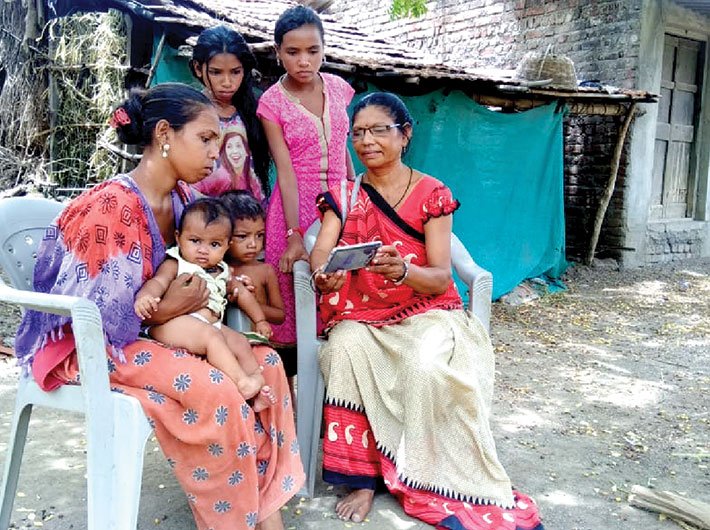Gujarat’s ImTeCHO app is helping health workers perform better and improve infant and maternal mortality rates
Courier services and sales teams have soared into efficiency using smartphone apps to monitor deliveries, visits, timeliness and performance. Taking a leaf from their book, Gujarat is equipping accredited social health activists (ASHAs) and midwives with smartphones and an app to bring down infant and maternal mortality rates (MMR) and improve post-natal care. Results have been promising: MMR, for instance, has fallen from 112 (per 1,000) in 2011-13 to 91 (per 1,000) in 2014-16, reducing to two-digit figures for the first time.
The health department realised that data collection, collation, analysis and intervention were the key steps to keeping women in rural areas healthy and well-nourished during and after pregnancy and giving newborns the medical attention they need. It is in this the app worked wonders. Pilot projects since 2013, administered by the non-profit SEWA Rural, Jhagadia, in vulnerable districts with largely tribal populations, saw marked improvement.
Dr Shrey Desai of SEWA Rural says that randomised trials in the Bharuch (2013), Narmada (2014) and Valsad (2014-15) districts saw a 16 percent reduction in infant mortality, a 52 percent increase in cases of exclusive breast-feeding, and a 61 percent increase in post-natal care. ASHAs and auxiliary nurse-midwives (ANMs) here were given smartphones with a built-in app called ImTeCHO (innovative mobile-phone technology for community health operations). These frontline health workers were trained to think of themselves as mobilisers and service providers who used the app to record details such as nutrition levels, vaccination dates, pre- and post-natal check-ups, schedule visits and follow-ups, and inform block-, taluka-, and district-level health authorities about where special intervention might be needed. Monthly and weekly work plans, to-do lists, checklists can be consulted on the app itself. There are daily reminders of visits to be made. There are even provisions for video-counselling.
Since the data is transmitted almost instantly to the authorities, they had a big-picture view and a micro-level view, down to which village and which house needed special attention. The health workers can work on the app and enter data even without an internet connection, however, the entered data is transmitted once the connection is available. The authorities are able to keep track of the performance of ASHAs and ANMs: at a glance they can identify efficient performers and laggards.
App facts
- ASHAs and nurse-midwives have been given smartphones with the ImTeCHO app to record visits and key data, remind them of work plans, cases needing special attention etc.
- Cost per GPRS enabled smartphone is Rs.4,500. Monthly cost for using it is Rs.15-20.
- Users are given three days’ training in using the app.
- Time-stamped data is sent to a server, so health authorities are able to make interventions and monitor performance.
- App runs well even on a 2G network. If connection is not available, data is stored and transmitted whenever it becomes available.
ImTeCHO is similar to the mother and child tracking system (MCTS) of the central government. In fact, the two are interoperable and in future, the government may think of making them complementary to each other. In some ways, though, ImTeCHO is better: for instance, MCTS provides work plans only for ANMs and female health workers, while ImTeCHO provides it to ASHAs, who work one level lower. It also helps in evaluating performance, providing incentives, managing supply and tracking high-risk cases while also serving as a port for point-of-care data entry.
The state implemented the app-driven initiative in five more districts before deciding that it is scalable for the entire state. Already, 500 ASHAs have been using the app, helping over 50,000 women. Prime minister Narendra Modi launched the programme for state-wide use of the app in Vadnagar in 2017. Given his penchant for wordplay, he renamed the app Techo, punning on the Gujarati word for support. State health commissioner Jayanti Ravi says the app is field-tested and ready, and by June-end will be in use across the state. This initiative will segue into complete digitisation of the health data of over 60 million people.
Gujarat’s healthcare system has often been criticised for poor infant and maternal mortality rates in some pockets, for example, Mehsana, where the sex ratio for children is as low as 842 females per 1,000 males. Comparably affluent states like Maharashtra and Punjab have a better record. Gujarat’s current boast, an MMR of 91, is way higher than Kerala (46), Tamil Nadu (66), Andhra Pradesh (74) and Telangana (81). The MMR in Haryana, currently 101, is way better than Gujarat’s figures for 2004-06 (160), 2007-09 (148), and 2010-12 (122). Surprising, for the latter is known for its development and progressive attitudes since the days of the independence struggle. Gujarat compares well, though, with the national MMR rate of 130 (2014-16), down from 167 in 2011-13.
With support from ImTeCHO – or Techo, as the prime minister would have it – the picture could change greatly for the better. As Dr Desai, of SEWA Rural, says, the app takes the complexities out of data collection, which was a major bottleneck. Data collected during home visits gets collated without a time lag at the primary health centres, which are able to prepare monthly reports and forward them with ease. Risk stratification, drug availability, notifications about mothers and newborns at risk – all of it is on view on the system.
Deputy chief minister Nitinbhai Patel, who is in charge of the health portfolio, accepts that Gujarat has had a bad record but concerted action is changing that. He says the state has achieved the target of 100 percent institutionalised deliveries, which goes a long way in improving infant and maternal mortality rates. “We are focussing now on improving MMR even further,” he says. “As for child sex ratio, yes, in some pockets it has been less than 850, but it has improved with timely intervention. Strict action is also being taken against those who help couples identify the sex of the foetus.”
ASHAs and ANMs, the unsung footsoldiers of state healthcare, are extremely happy with the app. “Digital intervention is really a boon,” says a health worker from the primary health centre in Pundhara, Gandhinagar. “We now find it easy to prepare reports. What used to take a month is done in days.” The real proof of the app’s efficacy, however, will be when digital intervention translates into really low infant and maternal mortality rates.
swati@governancenow.com
(The story appears in the June 30, 2018 issue)

